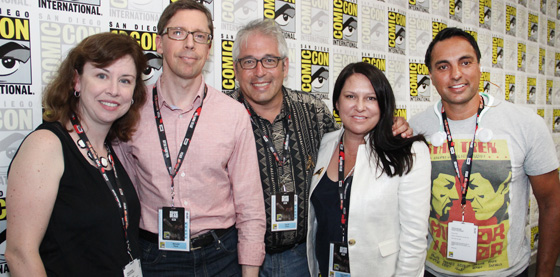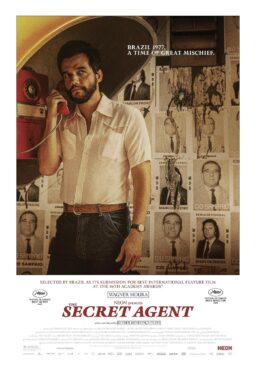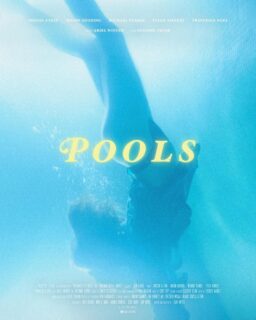This past Friday’s panel event, “Trek Talks: Science, Smithsonian and ‘Star Trek'” will make you want to travel to Washington, DC or Seattle. The panel discussed an upcoming two-hour documentary, “Building Star Trek,” which will premiere September 4, 8:00 pm. on the Smithsonian Channel and be available thereafter online. In the documentary, props are also used to take us beyond “Star Trek” and into the labs of real scientists.
The documentary not only looks at the restoration of the studio model of the Enterprise, but also the Seattle Experience Music Project (EMP) Museum’s restoration of the bridge from that show. The exhibit, “Star Trek: Exploring New Worlds,” includes props from five “Star Trek” TV series such as Captain Kirk’s command chair, the navigation console, original series costumes for Kirk, Spock, Uhura and McCoy, and the six-foot filming model of the Enterprise for “Star Trek: The Next Generation.”
Moderated by Dr. Margaret Weitekamp, the curator at the Smithsonian’s National Air and Space Museum, the panel included Brooks Peck, the curator of the EMP Museum in Seattle; David Grier, Professor of Physics and Director of the Center for Soft Matter Research at New York University; Sonny Kohli, Team Leader of Cloud DX; and Elizabeth Trojian, Executive Producer of the Smithsonian Channel’s “Building Star Trek.”
Trojian commented that making this documentary was a real joy. “When we started this project it was just unbelievable that so many incredible scientists were doing these amazing projects that came out of ‘Star Trek.'” Even through Trojian is a self-confessed “‘Next Gen’ freak,” her favorite “Star Trek” moment is the kiss between Kirk (William Shatner) and Uhura (Nichelle Nichols) in the episode “Plato’s Stepchildren.” Trojian reveals that Nichols told her the kiss was not that radical because Nichols’ grandparents were a biracial couple.
Before the panel even started, Sonny Kohli was surrounded by fans and photographers. With him was his team’s version of a “Star Trek” tricorder. His team are finalists in the Qualcomm Tricorder XPRIZE. Kohli introduced himself as an ICU internal specialist, like “Dr. House in Canada.” While volunteering in Haiti, he thought about making an application: a smartphone-based EKG. Later, he learned there was a competition to make a tricorder. His version is a small portable machine that could analyze 12 different conditions and all of your vital signs. Kohli’s team is the only Canadian team left in the competition.
His favorite “Star Trek” episode is “The Trouble With Tribbles.” Like many South Asian children he grew up being told he should be a doctor; that “Star Trek” episode made him realize that “something little can destroy our culture and our civilization.” In his case, creating something that can detect an outbreak at its source, such as a cough analyzer app, could map an outbreak’s progress.
Brooks Peck’s EMP museum opened a “Star Trek” exhibition in May in collaboration with CBS. The exhibit has 100 objects from 50 years of “Star Trek” and not only celebrates “Star Trek” but looks at “its cultural influence and its social influence; the values and how the ideas of ‘Star Trek’ bring out this passion and excitement in people.”
His favorite “Star Trek” moment is from the episode “Arena,” when Kirk must battle the Gorn. In that episode, a superior race pits the captains of two ships against each other in a trial by combat. The Gorn captain is defeated, but the episode “brings out the ‘Star Trek’ message when Kirk has the upper hand, he shows mercy.”
David Grier has done research into the possibly of developing tractor beams. According to Grier, “waves like light don’t always have to push.” He explained, “All waves push … What we realized when an experiment went wrong was that waves don’t have to push. Sometimes, if you structure it right, they can pull, too.” For him, that meant a “tractor beam.” He then stated, “We didn’t invent the tractor beam; we discovered it.” His team learned that “a wave travels out from the source, lights you up and then pulls you back in.” Yet don’t expect help pulling a load of bricks from one place to another. Grier said, “Things that it can pull right now are microscopic” such as “ice crystals that orbit the earth just outside our atmosphere (deposited there by comets).” Practical applications would be putting a lighter version on the space station to extract those ice crystals, or to use it to get particles from extremely hot places on earth, active volcanoes.
“Star Trek: The Original Series” aired its first episode on September 8, 1966; “Building Star Trek” will air on September 4, days before the official anniversary.












